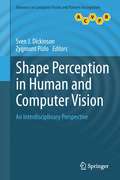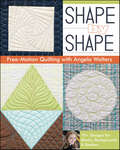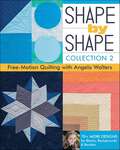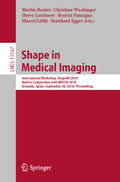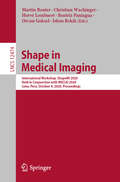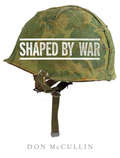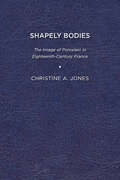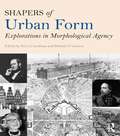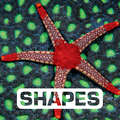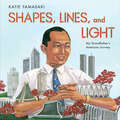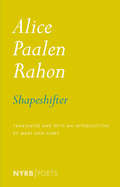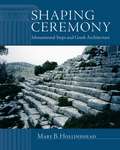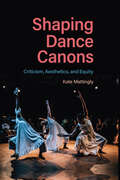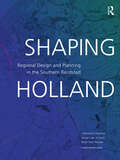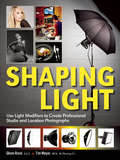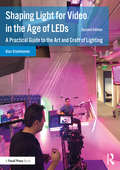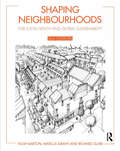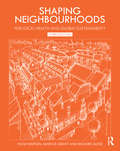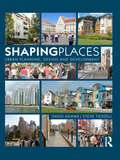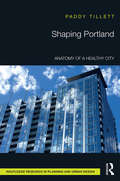- Table View
- List View
Shape Perception in Human and Computer Vision: An Interdisciplinary Perspective
by Sven J. Dickinson Zygmunt PizloThis comprehensive and authoritative text/reference presents a unique, multidisciplinary perspective on Shape Perception in Human and Computer Vision. Rather than focusing purely on the state of the art, the book provides viewpoints from world-class researchers reflecting broadly on the issues that have shaped the field. Drawing upon many years of experience, each contributor discusses the trends followed and the progress made, in addition to identifying the major challenges that still lie ahead. Topics and features: examines each topic from a range of viewpoints, rather than promoting a specific paradigm; discusses topics on contours, shape hierarchies, shape grammars, shape priors, and 3D shape inference; reviews issues relating to surfaces, invariants, parts, multiple views, learning, simplicity, shape constancy and shape illusions; addresses concepts from the historically separate disciplines of computer vision and human vision using the same "language" and methods.
Shape Your Memories: Creating One-of-a-Kind Scrapbook Pages
by Patti SwobodaTransform square and rectangular scrapbook pages and page protectors into any shape imaginable! With Patti Swoboda's innovative technique, scrapbookers of all ages and skill levels can create shaped pages that will add excitement and new dimension to their albums. Readers will learn, through step-by-step instructions and photographs, the basic technique for creating shaped pages using common scrapbooking tools and Staedtler's Hot Foil Pen. They will then be guided through the process of taking a basic pattern and turning it into different variations, including a bell that can be transformed into a frog, penguin, elephant, and even a dog! Bonus ideas for using decorative edge scissors are also presented. Groundbreaking technique in scrapbooking Detailed, step-by-step instructions and photographs ensure success Features 12 projects for shaped scrapbook pages and protectors Full-size patterns
Shape by Shape Free—Motion Quilting: 70+ Designs for Blocks, Backgrounds & Borders
by Angela WaltersGet into shape: The ultimate visual guide for free-motion quilting in specific geometric shapes • Follow step-by-step illustrations to create more than 70 free-motion quilting designs to use in specific shapes, negative space, and borders • Features full-page quilt photos, close-up details of stitched designs, and a comprehensive visual index • Best-selling author Angela Walters takes you to the next level in free-motion quilting by showing you how to manipulate shapes into modern designs It's easy to plan your machine quilting - simply open Shape by Shape Free-Motion Quilting with Angela Walters and find creative inspiration on every page. User-friendly and visually exciting, the contents are first divided into three sections: Blocks, Negative Space, and Borders. Then, to make it even more accessible, the Blocks section is further organized by five shapes: Squares, Triangles, Circles, Diamonds, and Hexagons. With an illustrated index, more than 70 free-motion quilting designs, crystal-clear instructions, and gorgeous full-page photographs, this is the go-to resource you’ll want handy before starting any quilting project.
Shape by Shape: Free-Motion Quilting with Angela Walters
by Angela WaltersBest-selling author...Over 75,000 books sold! You asked for it…you’ve got it! Best-selling author Angela Walters is back with 70+ all-new free-motion designs and variations to take your quilting to the next level. Tackle your quilt top one bite at a time, with ideas for quilting specific shapes—squares, rectangles, triangles, circles, diamonds, and hexagons—plus background fillers and borders. Quilt planning is easier than ever with step-by-step illustrations and detail shots of each motif, plus stunning full-page quilt photos and a handy visual index. Each versatile design is perfect for use with your longarm, midarm, or home sewing machine. • Take the next step in free-motion quilting! Angela Walters shares 70+ free-motion quilting designs and variations to mix and match • Gorgeous designs for every shape—quilt blocks, backgrounds, and borders • Step-by-step illustrations, visual index, full-page quilt photos, and photo details of motifs • For longarm, midarm, and domestic sewing machines
Shape in Medical Imaging: International Workshop, ShapeMI 2018, Held in Conjunction with MICCAI 2018, Granada, Spain, September 20, 2018, Proceedings (Lecture Notes in Computer Science #11167)
by Martin Reuter Christian Wachinger Hervé Lombaert Beatriz Paniagua Marcel Lüthi Bernhard EggerThis book constitutes the proceedings of the Workshop on Shape in Medical Imaging, ShapeMI 2018, held in conjunction with the 21st International Conference on Medical Image Computing, MICCAI 2018, in Granada, Spain, in September 2018. The 26 full papers and 2 short papers presented were carefully reviewed and selected for inclusion in this volume. The papers discuss novel approaches and applications in shape and geometry processing and their use in research and clinical studies and explore novel, cutting-edge theoretical methods and their usefulness for medical applications, e.g., from the fields of geometric learning or spectral shape analysis.
Shape in Medical Imaging: International Workshop, ShapeMI 2020, Held in Conjunction with MICCAI 2020, Lima, Peru, October 4, 2020, Proceedings (Lecture Notes in Computer Science #12474)
by Martin Reuter Christian Wachinger Hervé Lombaert Orcun Goksel Islem Rekik Beatriz PaniaguaThis book constitutes the proceedings of the International Workshop on Shape in Medical Imaging, ShapeMI 2020, which was held in conjunction with the 23rd International Conference on Medical Image Computing and Computer Assistend Intervention, MICCAI 2020, in October 2020. The conference was planned to take place in Lima, Peru, but changed to a virtual format due to the COVID-19 pandemic. The 12 full papers included in this volume were carefully reviewed and selected from 18 submissions. They were organized in topical sections named: methods; learning; and applications.
Shape in Medical Imaging: International Workshop, ShapeMI 2023, Held in Conjunction with MICCAI 2023, Vancouver, BC, Canada, October 8, 2023, Proceedings (Lecture Notes in Computer Science #14350)
by Christian Wachinger Beatriz Paniagua Jan Egger Jianning Li Shireen ElhabianThis volume comprises the proceedings of the International Workshop, ShapeMI 2023, which took place alongside MICCAI 2023 on October 8, 2023, in Vancouver, British Columbia, Canada.The 23 selected full papers deal with all aspects of leading methods and applications for advanced shape analysis and geometric learning in medical imaging.
Shaped By War
by Don McCullinNo other photographer in modern times has recorded war and its aftermath as widely and unsparingly as Don McCullin. After a childhood in London during the Blitz, and after the hardships of evacuation, McCullin feels his life has indeed been shaped by war.From the building of the Berlin Wall at the height of the Cold War to El Salvador and Kurdistan, McCullin has covered the major conflicts of the last fifty years, with the notable exception of the Falklands, for which he was denied access. His pictures from the Citadel in Hue and in the ruins of Beirut are among the most unflinching records of modern war. The publication of many of his greatest stories in the Sunday Times magazine did much to raise the consciousness of a generation, even if he himself now fears that photographs cannot prevent history from repeating itself. The brutality of conflict returns over and over again. McCullin here voices his despair.McCullin recounts the course of his professional life in a series of devastating texts on war, the events and the power of photography. The conclusion of the book marks McCullin’s retreat to the Somerset landscape surrounding his home, where the dark skies over England remind him yet again of images of war. Despite the sense of belonging and even contentment, for him there is no final escape.
Shapely Bodies: The Image of Porcelain in Eighteenth-Century France (Studies in Seventeenth- and Eighteenth-Century Art and Culture)
by Christine A. JonesShapely Bodies: The Image of Porcelain in Eighteenth-Century France constructs the first cultural history of porcelain making in France. It takes its title from two types of “bodies” treated in this study: the craft of porcelain making shaped clods of earth into a clay body to produce high-end commodities and the French elite shaped human bodies into social subjects with the help of makeup, stylish patterns, and accessories. These practices crossed paths in the work of artisans, whose luxury objects reflected and also influenced the curves of fashion in the eighteenth century. French artisans began trials to reproduce fine Chinese porcelain in the 1660s. The challenge proved impossible until they found an essential ingredient, kaolin, in French soil in the 1760s. Shapely Bodies differs from other studies of French porcelain in that it does not begin in the 1760s at the Sèvres manufactory when it became technically possible to produce fine porcelain in France, but instead ends there. Without the secret of Chinese porcelain, artisans in France turned to radical forms of experimentation. Over the first half of the eighteenth century, they invented artificial alternatives to Chinese porcelain, decorated them with French style, and, with equal determination, shaped an identity for their new trade that distanced it from traditional guild-crafts and aligned it with scientific invention. The back story of porcelain making before kaolin provides a fascinating glimpse into the world of artisanal innovation and cultural mythmaking. To write artificial porcelain into a history of “real” porcelain dominated by China, Japan, and Meissen in Saxony, French porcelainiers learned to describe their new commodity in language that tapped into national pride and the mythic power of French savoir faire. Artificial porcelain cut such a fashionable image that by the mid-eighteenth century, Louis XV appropriated it for the glory of the crown. When the monarchy ended, revolutionaries reclaimed French porcelain, the fruit of a century of artisanal labor, for the Republic. Tracking how the porcelain arts were depicted in documents and visual arts during one hundred years of experimentation, Shapely Bodies reveals the politics behind the making of French porcelain’s image. Published by University of Delaware Press. Distributed worldwide by Rutgers University Press.
Shapers of Urban Form: Explorations in Morphological Agency
by Peter J. Larkham Michael P. ConzenPeople have designed cities long before there were urban designers. In Shapers of Urban Form, Peter Larkham and Michael Conzen have commissioned new scholarship on the forces, people, and institutions that have shaped cities from the Middle Ages to the present day. Larkham and Conzen collect new essays in "urban morphology," the people-centered predecessor to contemporary theories of top-down urban design. Shapers of Urban Form focuses on the social processes that create patterns of urban forms in four discrete periods: Pre-modern, early modern, industrial-era and postmodern development. Featuring studies of English, American, Western and Eastern European, and New Zealand urban history and urban form, this collection is invaluable to scholars of urban design and town planning, as well as urban and economic historians.
Shapes (Picture This)
by Judith NouvionShapes are everywhere in nature. Discover many different kinds in these eye-catching photographs of animals in our natural world. From the line that pigeons form on a telephone wire to the square body of a ghost crab, children will find the many shapes that exist in our natural world in vibrant color photography. Perfect for very new and curious learners!
Shapes of Imagination: Calculating in Coleridge's Magical Realm
by George StinyVisual calculating in shape grammars aligns with art and design, bridging the gap between seeing (Coleridge's &“imagination&”) and combinatoric play (Coleridge's &“fancy&”).In Shapes of Imagination, George Stiny runs visual calculating in shape grammars through art and design—incorporating Samuel Taylor Coleridge's poetic imagination and Oscar Wilde's corollary to see things as they aren't. Many assume that calculating limits art and design to suit computers, but shape grammars rely on seeing to prove otherwise. Rules that change what they see extend calculating to overtake what computers can do, in logic and with data and learning. Shape grammars bridge the divide between seeing (Coleridge's &“imagination, or esemplastic power&”) and combinatoric play (Coleridge's &“fancy&”).Stiny shows that calculating without seeing excludes art and design. Seeing is key for calculating to augment creative activity with aesthetic insight and value. Shape grammars go by appearances, in a full-fledged aesthetic enterprise for the inconstant eye; they answer the question of what calculating would be like if Turing and von Neumann were artists instead of logicians. Art and design are calculating in all their splendid detail.
Shapes, Lines, and Light: My Grandfather's American Journey
by Katie YamasakiKatie Yamasaki’s newest picture book celebrates the life of her grandfather, the acclaimed Japanese American architect Minoru Yamasaki. Minoru Yamasaki described the feeling he sought to create in his buildings as “serenity, surprise, and delight.” Here, Katie Yamasaki charts his life and work: his childhood in Seattle’s Japanese immigrant community, paying his way through college working in Alaska’s notorious salmon canneries, his success in architectural school, and the transformative structures he imagined and built. A Japanese American man who faced brutal anti-Asian racism in post–World War II America and an outsider to the architectural establishment, he nonetheless left his mark on the world, from the American Midwest to New York City, Asia, and the Middle East. This striking picture book renders one artist’s work through the eyes of another, and tells a story of a man whose vision, hard work, and humanity led him to the pinnacle of his field.
Shapeshifter
by Alice Paalen RahonPoetry by one of the most powerful female figures in twentieth-century surrealism, now collected in English for the very first time.Alice Paalen Rahon was a shapeshifter, a surrealist poet turned painter who was born French and died a naturalized citizen of Mexico. Her first husband was the artist Wolfgang Paalen, among her lovers were Pablo Picasso and the poet Valentine Penrose, and over the years her circle of friends included Frida Kahlo and Diego Rivera, Joan Miró, Paul Éluard, Man Ray, and Anaïs Nin. This bilingual edition of Rahon&’s poems confirms the achievement of this little-known but visionary writer who defies categorization. Her spellbinding poems, inspired by prehistoric art, lost love, and travels around the globe, weave together dream, fantasy, and madness. For the first time in any language, this book gathers the three collections of poetry Rahon published in her lifetime, along with uncollected and unpublished poems and an album of portraits, manuscript pages, and artworks.
Shaping Ceremony
by Mary B. HollinsheadOffering a fresh approach to ancient Greek architecture, Shaping Ceremony focuses on the overlooked subject of monumental steps. Written in a clear and readable style, the book presents three complementary ways of studying steps: examining how the human body works on steps; theoretical perspectives on the relationship between architecture and human behavior; and the socio-political effects of steps' presence. Although broad steps are usually associated with emperors and political dominance, Mary B. Hollinshead argues that earlier, in Greek sanctuaries, they expressed and reinforced communal authority. From this alternate perspective, she expands the traditional intellectual framework for studying Greek architecture. The heart of the study is a close reading of thirty-eight sites with monumental steps from the sixth through second centuries B. C. Organized by century, the book tracks the development of built pathways and grandstands for crowds of worshippers as evidence of the Greeks' increasing awareness of the power of architecture to shape behavior and concentrate social energy. With photographs and illustrations of plans, Shaping Ceremony offers a clear account of how Greeks' adaptation of terrain for human use promoted social cohesion and integrated architectural compositions.
Shaping Dance Canons: Criticism, Aesthetics, and Equity
by Kate MattinglyExamining a century of dance criticism in the United States and its influence on aesthetics and inclusion Dance criticism has long been integral to dance as an art form, serving as documentation and validation of dance performances, yet few studies have taken a close look at the impact of key critics and approaches to criticism over time. The first book to examine dance criticism in the United States across 100 years, from the late 1920s to the early twenty-first century, Shaping Dance Canons argues that critics in the popular press have influenced how dance has been defined and valued, as well as which artists and dance forms have been taken most seriously. Kate Mattingly likens the effect of dance writing to that of a flashlight, illuminating certain aesthetics at the expense of others. Mattingly shows how criticism can preserve and reproduce criteria for what qualifies as high art through generations of writers and in dance history courses, textbooks, and curricular design. She examines the gatekeeping role of prominent critics such as John Martin and Yvonne Rainer while highlighting the often-overlooked perspectives of writers from minoritized backgrounds and dance traditions. The book also includes an analysis of digital platforms and current dance projects—On the Boards TV, thINKingDANCE, Black Dance Stories, and amara tabor-smith’s House/Full of BlackWomen—that challenge systemic exclusions. In doing so, the book calls for ongoing dialogue and action to make dance criticism more equitable and inclusive.
Shaping Holland: Regional Design and Planning in the Southern Randstad
by Jeroen van Schaick Francisco Colombo Peter WitsenAll around the world, regions are facing major challenges: climate change, the transition to renewable energy, reinventing the food system, ongoing urbanisation and finding room to sustain biodiversity. These will radically transform our living and working environments. Regional design uses the power of visualisation to unite regional players around appealing spatial development visions for meeting those challenges. It offers a route to new forms of regional governance and planning that match the urgencies of our time. This book exposes the benefits and the pitfalls of regional plans and designs. Shaping Holland gives a unique insight into the emergence of contemporary regional planning and design practice in the Netherlands. This densely populated country in the delta of the Rhine and Meuse rivers is internationally renowned for its urban planning and design tradition. Drawing on first-hand accounts and a rich collection of illustrations, maps and diagrams, the book gives pointers for practitioners, academics and students of spatial planning, urban design and landscape architecture. Regional design is on the rise in all continents. It provides an answer to a world in which economic activities, activity patterns, urban growth and ecological systems are no respecters of administrative boundaries. Amid the growing number of academic analyses of regional design, this book is unique because it focuses on planning practice and first-hand knowledge. As such it is of interest to a broad international readership.
Shaping Jerusalem: Spatial planning, politics and the conflict
by Francesco ChiodelliShaping Jerusalem: Spatial planning, politics and the conflict focuses on a hidden facet of the Israeli-Palestinian conflict; the relentless reshaping of the Holy City by the Israeli authorities through urban policies, spatial plans, infrastructural and architectural projects, land use and building regulations. From a political point of view, the Israeli-Palestinian conflict may appear to be at an impasse; however, it is precisely by looking at the city’s physical space that one can perceive that a war of cement and stone is under way. Many books have been written on the Israeli-Palestinian conflict over Jerusalem; some of them have focused on the urban fabric; Shaping Jerusalem uniquely discusses the role of Israeli spatial actions within the conflict. It argues that Israel’s main political objective – control over the whole city – is ordinarily and silently pursued through physical devices which permanently modify the territory and the urban fabric. Relying on strong empirical evidence and data through the analysis of statistical data, official policies, urban projects, and laws, author Francesco Chiodelli substantiates the political discussion with facts and figures about the current territorial situation of the city, and about the Israeli policies implemented in the city in the past six decades.
Shaping Light
by Glenn Rand Tim MeyerWhether shooting portraits or products, skillful lighting can be the difference between a bland snapshot and a stunning, well-defined image. Capturing the ideal photograph requires many technical factors to work in tandem, the most fundamental of which is lighting. While we may take it for granted that light is required to create a photograph, light by itself usually does not produce the style, energy, emotion or feeling that makes a photograph exceptional. It is the way the light has been modified and shaped that gives the photographer the ability to create an image that communicates their feeling about the subject. It's necessary to understand how light works in order to know how to modify it in the most desirous way.Beginning with simplified light concepts, Rand delves into the basics of light. Light's natural tendency is to go off in all directions. To give a better understanding of how to control the light that you use in your photographs, Rand guides the reader through a series of discussions defining the light itself, the surfaces that will interact with the light in the photographs, the look of light that we wish to create and the tools, modifiers and shapers that are commonly available for use. Whether you want to add contrast with highlights and shadows or use the softness of diffuse light to add volume to the subject, the fundamentals of these concepts are covered here. Images, diagrams and descriptions are used to illustrate the manners in which light can be modified.From there, the book moves onto the main tools of light modification. Rand discusses the primary functions of each tool and defines the issues of the light's characteristics after the modification. Techniques are presented for using reflectors, spotlights, softboxes, diffusers, umbrellas, barndoors, gels, scrims, shoots and more. Each chapter is highly illustrated with images of the tools being discussed, diagrams, and examples for the use of these tools in both commercial and portrait photography. Variations in control and problems that may occur with specific modifiers are discussed as well.The goal of this book is to show the effect of modifiers and shapers on the quality of light rather than to discuss the merits of a particular light source. By focusing on the methods to shape light, the photographer is open to improvise in scenarios where they may not have control over the light source. Whether you shoot commercial or portrait photography, this book provides you with the basis for not only successfully, but elegantly shaping light to create your desired result.
Shaping Light
by Glenn Rand Tim MeyerWhether shooting portraits or products, skillful lighting can be the difference between a bland snapshot and a stunning, well-defined image. Capturing the ideal photograph requires many technical factors to work in tandem, the most fundamental of which is lighting. While we may take it for granted that light is required to create a photograph, light by itself usually does not produce the style, energy, emotion or feeling that makes a photograph exceptional. It is the way the light has been modified and shaped that gives the photographer the ability to create an image that communicates their feeling about the subject. It's necessary to understand how light works in order to know how to modify it in the most desirous way.Beginning with simplified light concepts, Rand delves into the basics of light. Light's natural tendency is to go off in all directions. To give a better understanding of how to control the light that you use in your photographs, Rand guides the reader through a series of discussions defining the light itself, the surfaces that will interact with the light in the photographs, the look of light that we wish to create and the tools, modifiers and shapers that are commonly available for use. Whether you want to add contrast with highlights and shadows or use the softness of diffuse light to add volume to the subject, the fundamentals of these concepts are covered here. Images, diagrams and descriptions are used to illustrate the manners in which light can be modified.From there, the book moves onto the main tools of light modification. Rand discusses the primary functions of each tool and defines the issues of the light's characteristics after the modification. Techniques are presented for using reflectors, spotlights, softboxes, diffusers, umbrellas, barndoors, gels, scrims, shoots and more. Each chapter is highly illustrated with images of the tools being discussed, diagrams, and examples for the use of these tools in both commercial and portrait photography. Variations in control and problems that may occur with specific modifiers are discussed as well.The goal of this book is to show the effect of modifiers and shapers on the quality of light rather than to discuss the merits of a particular light source. By focusing on the methods to shape light, the photographer is open to improvise in scenarios where they may not have control over the light source. Whether you shoot commercial or portrait photography, this book provides you with the basis for not only successfully, but elegantly shaping light to create your desired result.
Shaping Light for Video in the Age of LEDs: A Practical Guide to the Art and Craft of Lighting
by Alan SteinheimerA practical, hands-on guide to lighting for video, this book explores how LEDs are changing the aesthetics of lighting and provides students with an indispensable guide to the everyday techniques required to produce professional-quality lighting in the age of LEDs and wireless control options. The book focuses on first-hand application of technical knowledge, beginning with simple lighting setups and progressing to more complicated scenarios, and features accompanying diagrams, illustrations and case studies to demonstrate their real-world application. Key topics covered include basic three-point lighting, lighting moving actors, set lighting and exposure, instrument selection, bringing style to your lighting, color temperature and the Kelvin scale, exterior lighting, lighting categories and genres, green-screen techniques, money and budgeting, and electricity and electrical distribution. The book also provides guidance on career paths including what a grip does, case studies with photos and diagrams, and an extensive glossary of set terminology to introduce students to the language of filmmaking. A must-have resource for film and media production students taking classes in lighting and/or cinematography.
Shaping Neighbourhoods: For Local Health and Global Sustainability
by Hugh Barton Marcus Grant Richard GuiseThis substantially revised and important second edition comes at a pivotal time, with both a strong agenda of localism in planning and with public health professionals now realising the vital importance of shaping urban environments in order to reduce the burden of disease and support better health outcomes. This guide ensures you: understand the underlying principles for planning healthy and sustainable neighbourhoods and towns plan the collaborative and inclusive processes needed for multi-sectoral cooperation develop know-how and skills in matching local need with urban form discover new ways to integrate development with natural systems design places with character and recognise good urban form guide communities, and advise developers, in the creation of successful and sustainable places for living. Containing many new case studies and a wealth of new research, this new edition has benefited from previous user feedback. Shaping Neighbourhoods is the indispensable guide for bridging the gulf between theory and practice, between planning authorities, investors and communities, and between different professional perspectives. Whether you are a student faced with a local planning project; a planner, urban designer or developer involved in new development; a health authority concerned with promoting physical activity; or a community group wanting to improve your neighbourhood; this book is for you.
Shaping Neighbourhoods: For Local Health and Global Sustainability
by Hugh Barton Marcus Grant Richard GuiseShaping Neighbourhoods is unique in combining all aspects of the spatial planning of neighbourhoods and towns whilst emphasising positive outcomes for people’s health and global sustainability. This new edition retains the combination of radicalism, evidence-based advice and pragmatism that made earlier editions so popular. This updated edition strengthens guidance in relation to climate change and biodiversity, tackling crises of population health that are pushing up health-care budgets, but have elements of their origins in poor place spatial planning – such as isolation, lack of everyday physical activity, and respiratory problems. It is underpinned by new research into how people use their localities, and the best way to achieve inclusive, healthy, low-carbon settlements. The guide can assist with: • Understanding the principles for planning healthy and sustainable neighbourhoods and towns • Planning collaborative and inclusive processes for multi-sectoral working • Developing know-how and skills in matching local need with urban form • Discovering new ways to integrate development with natural systems • Designing places with character and recognising good urban form Whether you are a student faced with a local planning project; a public health professional, planner, urban designer or developer involved in new development or regeneration; a council concerned with promoting healthy and sustainable environments; or a community group wanting to improve your neighbourhood – you will find help here.
Shaping Places: Urban Planning, Design and Development
by David Adams Steve TiesdellShaping Places explains how towns and cities can turn real estate development to their advantage to create the kind of places where people want to live, work, relax and invest. It contends that the production of quality places which enhance economic prosperity, social cohesion and environmental sustainability require a transformation of market outcomes. The core of the book explores why this is essential, and how it can be delivered, by linking a clear vision for the future with the necessary means to achieve it. Crucially, the book argues that public authorities should seek to shape, regulate and stimulate real estate development so that developers, landowners and funders see real benefit in creating better places. Key to this is seeing planners as market actors, whose potential to shape the built environment depends on their capacity to understand and transform the embedded attitudes and practices of other market actors. This requires planners to be skilled in understanding the political economy of real estate development and successful in changing its outcomes through smart intervention. Drawing on a strong theoretical framework, the book reveals how the future of places will come to be shaped through constant interaction between State and market power. Filled with international examples, essential case studies, color diagrams and photographs, this is essential reading for undergraduate and graduate students taking planning, property, real estate or urban design courses as well as for social science students more widely who wish to know how the shaping of place really occurs.
Shaping Portland: Anatomy of a Healthy City
by Paddy TillettPortland is a young city founded on a river bank in a virgin forest less than 200 years ago. Shaping Portland: Anatomy of a Healthy City is about the values engendered by the place, and how those values have influenced the growing city. It examines how and why the public realm supports or obstructs the health-forward lifestyles of those who choose to live there. This book explores the values and dynamics that shaped a healthy city to enable those things. It is a case study of a recognized success – looking more closely at a recent urban infill: the Pearl District. The future roles of the planners and other design professionals in continuing to build healthy and responsive environments are suggested. The cities of the future will be those that we already inhabit, but infilled and adapted to tomorrow’s needs and values. Understanding the dynamics involved is essential for those in whose hands we entrust the design of cities and urban places.
